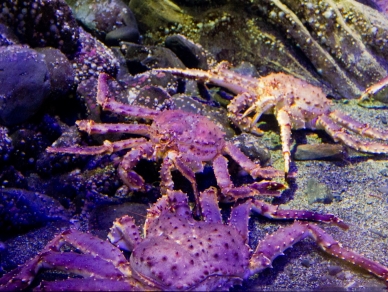Alaska Species Explorer
All
x
- – No known individuals remaining.
- – Known only to survive in captivity, or as a naturalized population outside its historic range.
- – Extremely high risk of extinction in the wild.
- – High risk of extinction in the wild.
- – High risk of endangerment in the wild.
- – Likely to become endangered in the near future.
- – Lowest risk. Does not qualify for a higher risk category. Widespread and abundant taxa are included in this category.
- – Not enough data to make an assessment of its risk of extinction.
- – Has not yet been evaluated against the criteria.
Red King Crab
- – No known individuals remaining.
- – Known only to survive in captivity, or as a naturalized population outside its historic range.
- – Extremely high risk of extinction in the wild.
- – High risk of extinction in the wild.
- – High risk of endangerment in the wild.
- – Likely to become endangered in the near future.
- – Lowest risk. Does not qualify for a higher risk category. Widespread and abundant taxa are included in this category.
- – Not enough data to make an assessment of its risk of extinction.
- – Has not yet been evaluated against the criteria.
Carapace (shell) length: up to 28cm (11in), Leg span: 1.5m (5ft), Maximum recorded weight (male): 10.9kg (24lbs). Females are smaller than males.
King crabs molt before mating in the spring just after previous eggs are hatched. Eggs are carried externally by the females and develop for close to one year with the hatch timed to the abundance of plankton in the spring. Larval crabs go through four molts called zoea followed by the glaucothoe stage which settles to the bottom. Subsequent molts are as a fully formed crab stage in which growth occurs during each subsequent molt. Juvenile crabs settle out in shallower waters. Red king crabs migrate to deeper water annually and back to shallower water to spawn. Maximum age can be up to 25 to 30 years although most do not survive this long.
King crabs are omnivorous and opportunistic: small invertebrates including worms, bivalve and gastropod mollusks, other crabs, echinoderms, and fish
Fish like cods, halibut and other flatfish species, sculpins and skates; octopus, other king crabs
Alaska Department of Fish and Game describes the status of red king crabs as healthy. However, most stocks of red king crabs in Alaska are depressed and fisheries there are limited or on hold. SE Alaska stocks are considered sizable enough to fish and there are some local stocks elsewhere in the state with highly regulated quotas.
King crab populations are cyclic with environmental conditions affecting numbers. Human harvest needs to be closely regulated to adjust for these changes in population and forecasting population changes is important in managing the fishery to avoid overharvest as has happened in the past.
Red king crab still is Alaska’s largest shellfish fishery. In 2011, 17 million pounds of red king crab were landed valued at over $110 million.
- Red king crabs are closely related to hermit crabs based on genetic analysis. Like hermit crabs, king crabs have different sized claws. The right claw is usually the larger and is shaped for crushing while the smaller claw seems to be used for tearing apart food.
- Other, less abundant king crabs in Alaska include the blue, golden and scarlet species.
-
King crabs form aggregations called pods where the animals stack up on one another in a behavior thought to be defense against predators. Pods can be several feet high and consist of thousands of crabs.








